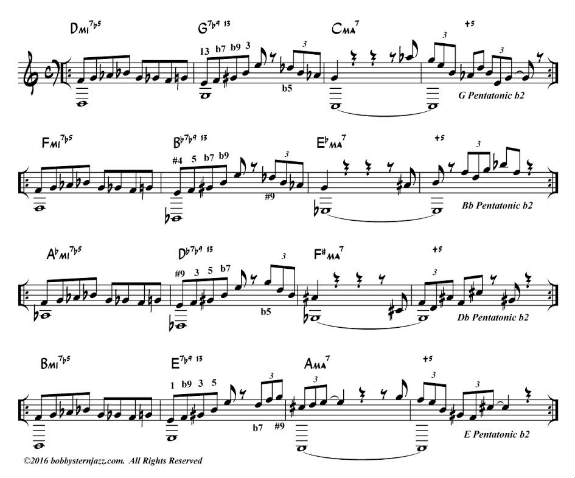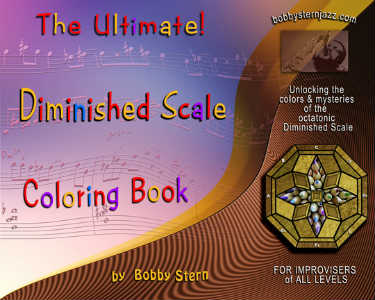Using the Diminished Scale ii-V7-I for Weaving In and Out of Changes

Stuck for ideas of what to play over that ii-V7? Give the octatonic (eight note) Diminished Scale a whirl. It’s a self contained, colorful, almost automatic source of melodic and harmonic tension and release that the masters have mastered since its inception.
Within this symmetric, octatonic galaxy resides every available dominant tension (with the exception of the b13), Major & minor triads, as well as minor & dominant 7th chords. It also hosts each and every interval in the chromatic universe
It’s also host to a number of very hip sounding altered penta and hexatonic / triad pair permutations.

CLICK HERE TO DOWNLOAD FULL SIZED SHEET MUSIC FOR EXERCISE ABOVE
The above graphic illustrates how a ii-V7 sequence can be built exclusively with material from a single Diminished Scale. Save for the chromatic passing tone in the first bar of each line (Gb in each case), all the melodic material is from the D, F, Ab, B Diminished Scale.
This example also attempts to illustrate how the same, or similar melodic material may be used over the different ii-V7 combinations native to a particular Diminished Scale – which, being the synthetic, symmetric pitch collection that it is – divides the octave into four equal parts and therefore repeats itself at intervals of a minor third.
As a result, any material from the same scale, harmonic or melodic, a minor third (up or down) or tritone away, can be interchanged and substituted for one another. This applies to chord progressions as well as melodic lines.
Getting back to the graphic, the melodic line for the whole first measure, and the first 3 beats of the second measure in each of the four lines of the example, is exactly the same. In fact, the first three-and-a-half beats of the third measure of the first two lines are identical, as well. Only the ii-V root movement changes, each one moving up a min. third with each line as you move down the page.
On the first beat of measure #3 of the third and fourth lines, the landing note changes in each case, resolving to an available chord tone of the appropriate tonic Major I chord. The preceding eighth note triplet is also modified melodically to smooth out the resolution. Conversely, and probably more commonly, the melodic line itself can be moved up or downin minor thirds and tritones against a set of static ii-V7 changes, with similar effect.
Although one might not normally think of the Diminished Scale as a source of coloring material for a tonic Major or Maj7 chord, well…think again.
As mentioned at the top of the article, the Diminished Scale is home to a number of altered pentatonics. A pentatonic scale, as you probably know, is technically any scale containing five notes. The most common pentatonic scale, the one heard in every kind of music imaginable form around the world and beyond for thousands of years, is the one derived from the Major scale by removing its tritone.
For example, if we remove the tritone (F & B) from a C Major scale, we’re left with C-D-E-G-A; familiar to the most casual of ears. If we were to put A on the bottom we would have a likewise very familiar minor pentatonic sound.
Again, back to the graphic. Let’s take a look at measure #4, Line #1; actually, the last eighth note of measure #3 could be included here, too. Naming the notes involved just once, we come up with Ab-G-E-B & D. Put them in an ascending sequential order starting with G, and we get G-Ab-B-D-E, known around town as G Pentatonic b2.
As you can see, as it says on the label, it’s a G Penatatonic with a flatted 2nd degree (Ab). As with its Major cousin, if we flip it and put E on the bottom, we get that hip minor / Major sound, utilized to great effect by just about any of the latter day improvisational luminaries (pick one). The Diminshed Scale contains 4 of these, each a minor third or tritone apart, of course.
But what about its use with a Maj.7 chord? Upon closer scrutiny of the C Maj7 in the final bar of line #1, we discover, my dear Watson, that the G Penta b2 provides us with the b6 or #5 (Ab), 5 (G), 3 (E), 7 (B) & 9 (D), in essence a nice little C Maj9+5 sound; its root, which is not native to the scale, being provided by the bass.
The #5 (aka +5) against the Major chord is very cool, as it gives the line a sense of delayed resolution. Even if you want to omit it, you’ve still got 3-5-7 & 9 to work with.
In listening to the audio example, the transposed root movement between lines gives off the illusion that the melody line has changed as well. This perceived effect is especially strong between the first two lines.
Also, the ii chord that begins the final line (B-7b5) sounds much more dissonant upon first its hearing than the others. However, if you listen to it before hearing the others, it doesn’t really sound dissonant at all; in fact, it even sounds kind of Monkish.
But, hey! Out ‘n’ In / In ‘n’ Out…that’s – what – it’s – all – a – bout (no doubt)!
Want to Dive Deeper?
Tons of additional info, exercises and examples in Bobby’s new eBook
The Ultimate! Diminished Scale Coloring Book,
available from bobbysternjazz.com
 .
.






August 30, 2019 @ 1:50 pm
I appreciate your sharing. It opened up some doors, affording me a different perspective and approach. I made a quantum leap instantly, esp. since I am not one to be in denial, making me a fast learner. Understanding makes a critical difference. You, being empathetic, simplify the abstract, making you a great teacher. Thanks so much. Keep up the great work.
November 7, 2019 @ 10:03 am
I play alto sax and I am interested in learning how to use modern ways to have my solos sound more interesting